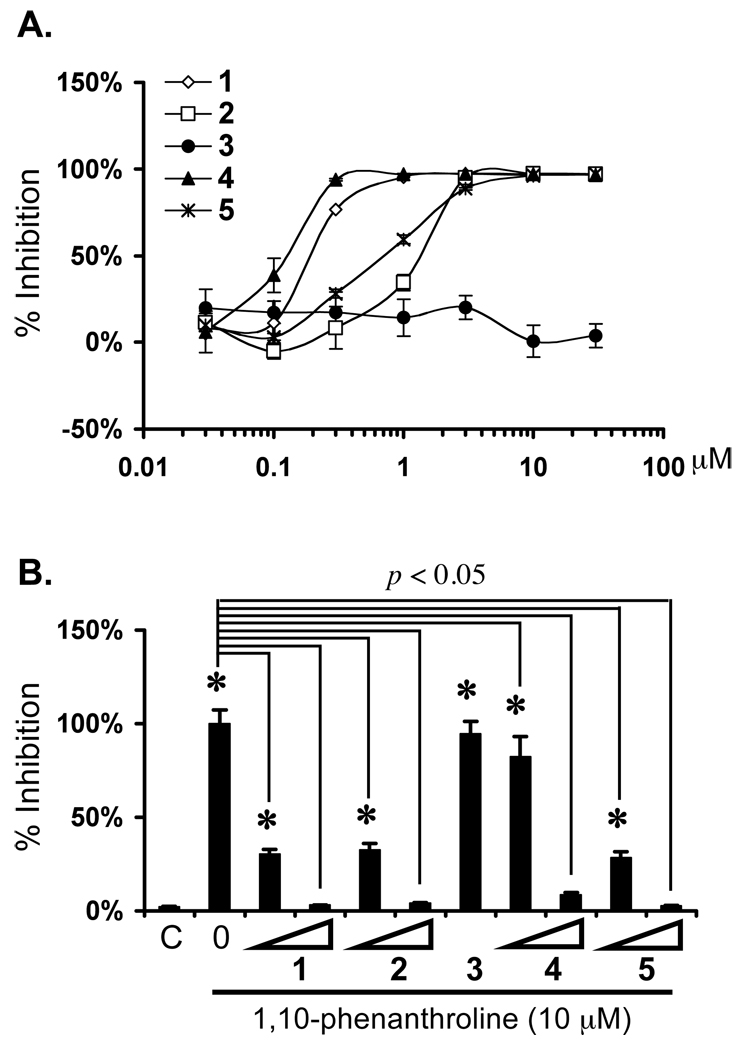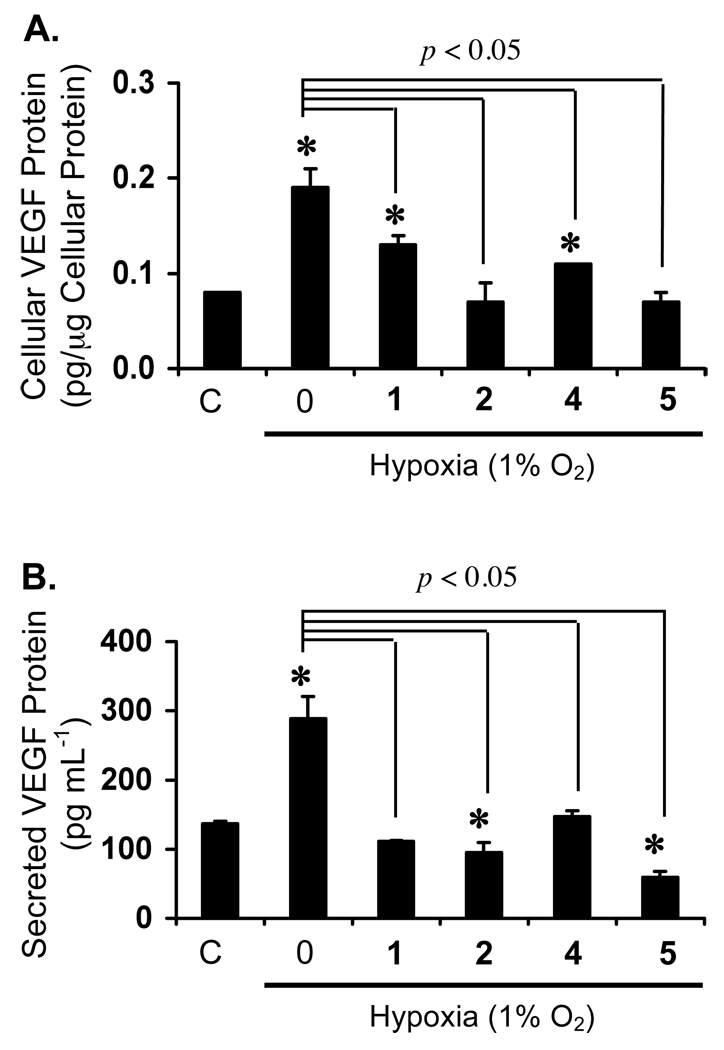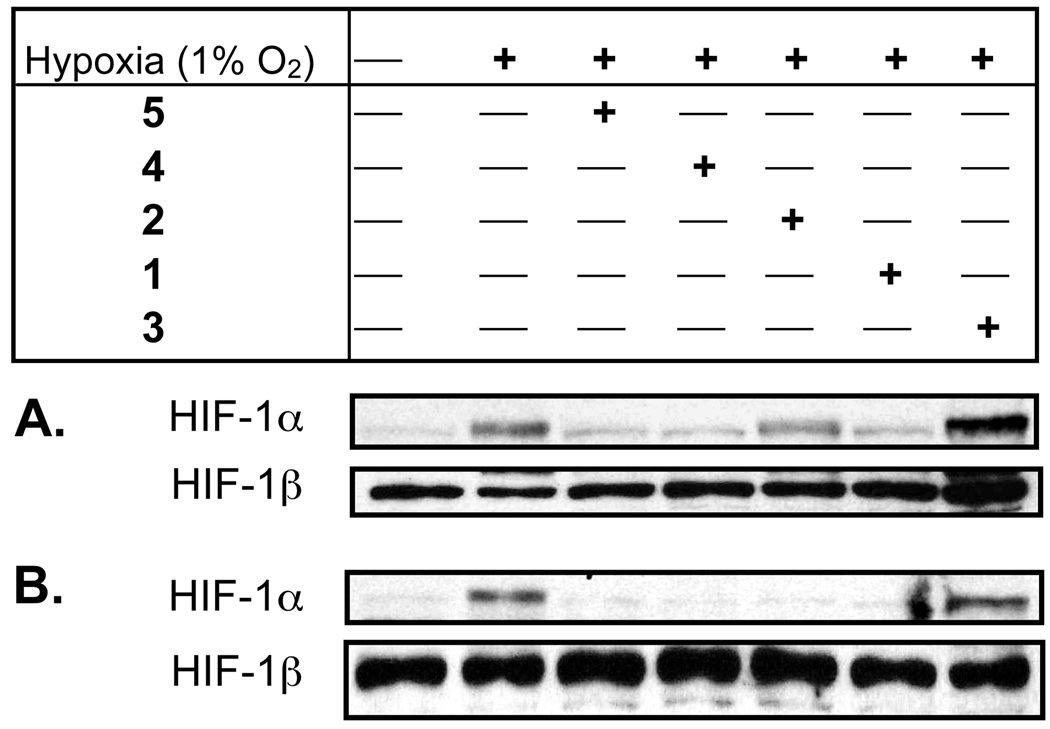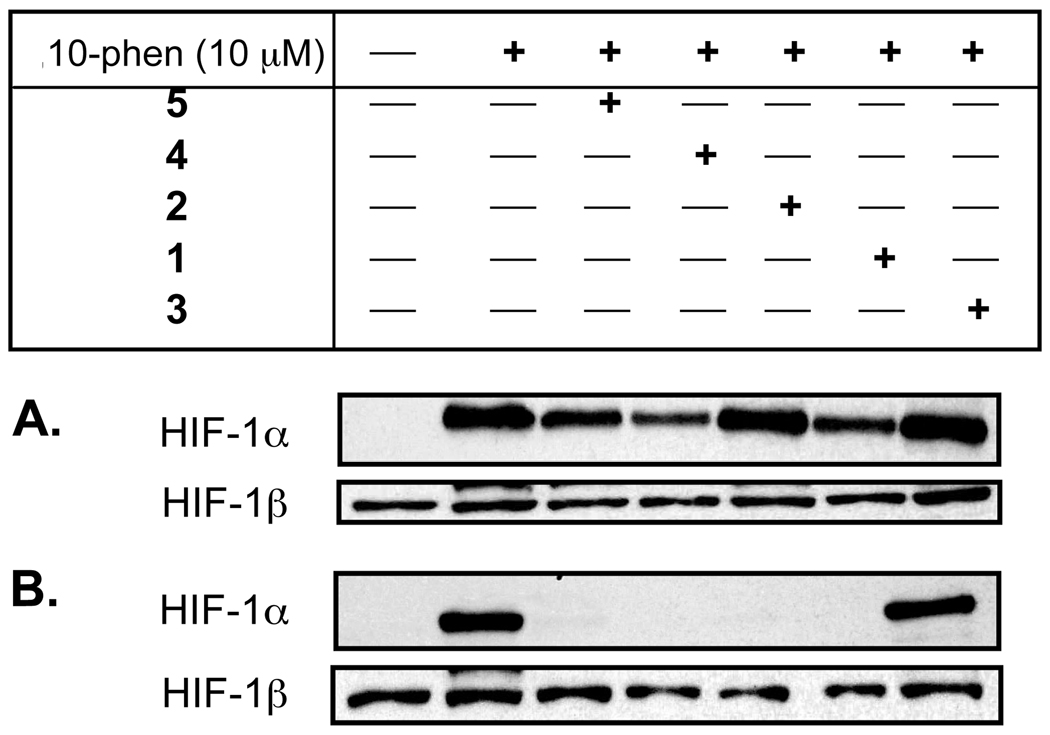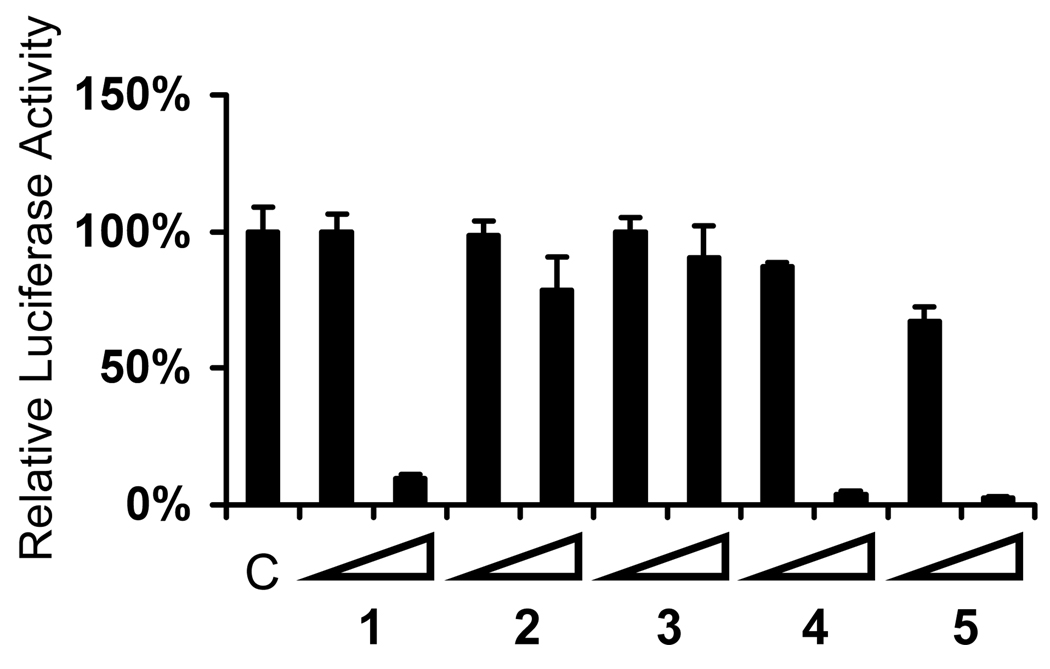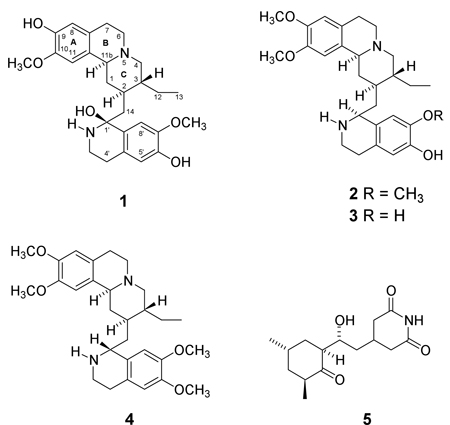Abstract
Klugine (1), isocephaeline (2), and emetine (4) inhibited hypoxia-inducible factor-1 (HIF-1) activation by hypoxia in T47D breast tumor cells (IC50 values 0.2, 1.1, and 0.11 µM, respectively). Compounds 1, 2, and 4 inhibited both hypoxia- and iron chelator-induced HIF-1 activation by blocking HIF-1α protein accumulation.
Within tumor masses, oxygen concentrations are highly variable, with oxygen partial pressures (pO2) in many regions less than 5 mmHg (approximately 0.7% O2).1 Depending on the specific tumor type, the median pO2 in tumors ranges from 5% to 34%, relative to those observed in the surrounding normal tissues.1 This reduction in oxygen tension (hypoxia) activates both cellular survival and cell death programs.2 In oncogenically transformed cells, hypoxia provides a physiological pressure and selects for the cells with diminished apoptotic potential.3 Hypoxic tumor cells that have adapted to oxygen and nutrient deprivation are associated with a more aggressive phenotype and poor prognosis.1,4
The transcription factor that plays a critical role in hypoxia-induced gene expression is hypoxia-inducible factor-1 (HIF-1), a heterodimer of the oxygen regulated HIF-1α and the constitutively expressed HIF-1β subunits.5 Upon activation, HIF-1 induces the expression of genes that promote adaptation and survival under hypoxic conditions. Clinical studies indicate that HIF-1α overexpression correlates directly with advanced disease stages and poor prognosis in cancer patients.6 The therapeutic potential of HIF-1 blockade for cancer treatment is supported by results from multiple studies employing animal models.7 Intense research efforts are currently directed at the discovery and development of small molecule HIF-1 inhibitors for cancer.5,8
To discover novel natural products that inhibit HIF-1, thousands of plant, marine invertebrate, and microbial extracts were evaluated in a T47D human breast tumor cell-based reporter assay for HIF-1 inhibitory activity.9 Three ethanol extracts prepared from different parts of the plant Psychotria klugii Standl. (Rubiaceae) all inhibited hypoxic activation of HIF-1 by greater than 90% at 5 µg mL−1. Chromatographic fractions of P. klugii extracts and subsequently isolated pure compounds from the active fractions were further tested for HIF-1 inhibitory activity. The terpenoid tetrahydroisoquinoline alkaloids klugine (1), isocephaeline (2), and 7'-Odemethylisocephaeline (3) are analogs of the natural product emetine (4).10 Emetine is a protein synthesis inhibitor that was evaluated in Phase II clinical studies as a potential chemotherapeutic agent for the treatment of solid tumors over 30 years ago.11 The protein synthesis inhibitor cycloheximide (5) has been shown to inhibit HIF-1 activation.12 Dose-response studies were performed to examine the effects of compounds 1–5 on HIF-1 activation by hypoxia (1% O2) in a T47D cell-based dual luciferase reporter assay.13 As shown in Figure 1A, compounds 1, 2, 4, and 5 all inhibited HIF-1 activation by hypoxia (1% O2, 16 h) while 3 was inactive at the concentrations tested (up to 30 µM). All four active compounds completely inhibited HIF-1 activation at 3 µM with 4 being the most potent inhibitor (IC50 0.11 µM, MIC 0.3 µM). Iron chelators and transition metals (such as cobalt and nickel) can activate HIF-1 and have been used as hypoxia mimetics.9,14 Using a similar assay system, the effects of 1–5 on HIF-1 activation by the Fe2+ chelator 1,10-phenanthroline were evaluated to discern the specificity of HIF-1 inhibition. Each active compound (1, 2, 4, and 5) was tested at two concentrations - IC50 and MIC (determined from Figure 1A) and the inactive 3 at one single concentration (10 µM). At the higher concentration (MIC), compounds 1, 2, 4, and 5 all completely inhibited HIF-1 activation by 1,10-phenanthroline while 3 remained inactive (Figure 1B). One notable observation is that 4 inhibited 1,10-phenanthroline-induced HIF-1 activation to a lesser degree (18% inhibition) at the concentration (0.11 µM) that inhibits hypoxia-activated HIF-1 by 50%. These results suggest that these active compounds target a process (or processes) common to both hypoxia-induced and iron chelator-induced HIF-1 activation. Klugine (1) and emetine (4) have comparable HIF-1 inhibitory activities (Figure 1A), yet differ in both the degree of hydroxylation and pattern of O-methylation. Klugine (1) is essentially 1´-hydroxyl-9,6´-O4 didemethylemetine. Apart from 6´-O-demethylation in 2, compound 2 and emetine (4) differ only in that they are C-1´epimers. Isocephaeline (2) has a S-configuration at C-1´, while emetine has a 1'R-configuration. However, 2 is approximately 10 times less potent than 4 at inhibiting hypoxia-induced HIF-1 (Figure 1A). Since klugine (1) is nearly as potent as 4, it is likely the 1´R-configuration is a critical structural requirement for sub-micromolar HIF-1 inhibitory activity. This observation is mirrored by the significantly greater antiparasitic activity that has also been recently demonstrated for the 1´R-configured benzoquinolizidine alkaloid cephaeline, relative to its 1´S-epimer isocephaeline (2).10 The fact that 7´-O-demethylisocephaeline (3) is essentially inactive (>27-fold less potent than 2) suggests that the 7´-methoxyl group is also essential for HIF-1 inhibitory activity. Among the compounds tested, 3 is also the least cytotoxic to T47D breast tumor cells in vitro (Supporting Information).
Figure 1.
Dose-response of 1–5 on hypoxia-induced HIF-1 activation (A) and 1,10-phenanthroline-induced HIF-1 activation (B). (A) T47D cells that were transiently transfected with the pTK-HRE3-luc construct and an internal control pRL-TK were incubated with test compounds for 30 min before exposed to hypoxic conditions (1% O2/94% N2/5% CO2) for 16 h. Following incubation, the cells were harvested and luciferase activities determined. Luciferase activity was normalized to that of the Renilla luciferase. The data are presented as percentage inhibition (as compared to the induced control) from one representative experiment performed in quadruplicate. Bars represent standard errors. (B) T47D cell-based dual luciferase reporter assay similar to that described for (A) except that 1,10-phenanthroline (10 µM) was used in place of the hypoxic conditions. An asterisk (*) indicates a significance of p < 0.05 when compared to the untreated control “C.” The compounds were tested at the following concentrations: 1 (0.2 and 1 µM); 2 (1.1 and 3 µM); 3 (10 µM); 4 (0.11 and 0.3 µM); and 5 (0.7 and 10 µM). All compounds except 3 exerted statistically significant (p < 0.05) inhibition of 1,10-phenanthroline-induced HIF-1 activation in T47D cells.
Over 60 genes have been identified to be regulated by HIF-1.5 One target gene that is induced by HIF-1 in most cell types is vascular endothelial growth factor (VEGF). As a potent angiogenic factor, VEGF functions at multiple stages of the angiogenic process. Currently, inhibition of VEGF is under intense clinical evaluation as a new non-cytotoxic strategy for the treatment of solid tumors.15 Hypoxia is a major tumor micro-environmental factor that induces VEGF expression.15 The compounds found to inhibit HIF-1 activation were evaluated for their ability to inhibit hypoxic induction of VEGF (Figure 2). Hypoxic treatment (1% O2, 16 h) increased both cellular and secreted VEGF protein production in T47D cells. When tested at the concentration equal to that of the MIC for HIF-1 activation in the reporter assay (determined from Fig. 1A), compounds 1, 2, 4, and 5 all significantly reduced the hypoxia-induced increase in cellular and secreted VEGF protein levels (Figure 2). Compounds 2 and 5 completely blocked the hypoxia-induced increase in cellular VEGF protein to levels that were statistically indistinguishable from that observed for a normoxic control (Figure 2A). Under these same conditions, compounds 1 and 4 inhibited the induction by 56% and 69%, respectively (Figure 2A). These compounds produced a similar effect on secreted VEGF protein levels (Figure 2B). While compounds 1 and 4 completely blocked the hypoxic induction of secreted VEGF protein, compounds 2 and 5 not only inhibited the hypoxic induction, these two compounds further reduced the secreted VEGF protein levels to a point significantly below that observed for the untreated T47D cells (69% and 43% of the normoxic control level, respectively). At these same MIC concentrations, none of the active compounds exerted any significant effect on T47D cell viability or proliferation under hypoxic conditions (Supporting Information).
Figure 2.
Inhibition of hypoxia-induced VEGF proteins in T47D cells. (A) VEGF protein levels in the cell lysates were determined by ELISA and normalized to the amount of cellular protein. Data shown are from one representative experiment performed in triplicate and the bars represent standard errors. An asterisk (*) indicates a significance of p < 0.05 when compared to the untreated control “C.” The compounds were tested at the following concentrations: 1 (1 µM); 2 (3 µM); 4 (0.3 µM); and 5 (10 µM). All compounds exhibited statistically significant (p < 0.05) inhibition of VEGF protein induction by hypoxia. (B) Secreted VEGF protein levels in the conditioned media were determined by ELISA. Compound treatments and data presentation are as described for (A).
In general, the availability and activity of the oxygen-regulated HIF-1α subunit determines HIF-1 activity.5,8 Under normoxic conditions, the HIF-1α subunit is post-translationally modified and rapidly degraded by the proteasome. Under hypoxic conditions, the HIF-1α subunit is stabilized and activated. The effects of compounds 1–5 on hypoxia-induced (1% O2) accumulation of nuclear HIF-1α protein in T47D cells were examined (Figure 3). All compounds were tested at two concentrations: 0.3 and 10 µM. At the higher concentration, all of the compounds found to inhibit HIF-1 (1, 2, 4, and 5) also blocked hypoxia-induced nuclear HIF-1α protein accumulation (Figure 3B). At the lower concentration, inhibition was only observed in the presence of 1, 4, and 5 (Figure 3A). The inactive analog 3 did not exert any effect on the induction of nuclear HIF-1α protein. Under experimental conditions, none of the compounds affected the levels of the constitutively expressed HIF-1β protein in the nucleus. A similar study was conducted to examine the effects of compounds 1–5 on iron chelator-induced HIF-1α protein accumulation (Figure 4). At the higher concentration, compounds 1, 2, 4, and 5 all blocked the induction of nuclear HIF-1α protein by 1,10-phenanthroline (10 µM, Figure 4B). At the lower concentration, only 1, 4, and 5 inhibited HIF-1α protein accumulation (Figure 4A). Compound 3 did not affect nuclear HIF-1α protein induction at either concentration.
Figure 3.
Effects of 1–5 on nuclear HIF-1α and HIF-1β proteins under hypoxic conditions. T47D cells were exposed to test compounds at 0.3 µM (A) and 10 µM (B) for 30 min prior to another 4 h incubation under hypoxic conditions (1% O2/94% N2/5% CO2). The relative level of HIF-1α protein in each T47D nuclear extract sample was determined by Western blot using a monoclonal anti-HIF-1α antibody. The membrane was then stripped and the level of HIF-1β protein was determined by Western blot using a monoclonal anti-HIF-1β antibody.
Figure 4.
Effects of 1–5 on nuclear HIF-1α and HIF-1β proteins in the presence of 1,10-phenanthroline. Experimental procedures were as described for Figure 3 except that 1,10-phenanthroline (10 µM) was used to induce HIF-1α protein.
Compounds 4 and 5 have both been demonstrated to inhibit protein synthesis at the aminoacyl transfer level.16 However, the effects of 1–3 on protein synthesis have not been reported. One possible mechanism of action for these HIF-1 inhibitors (1, 2, 4, and 5) is that they may inhibit de novo protein synthesis that is required for HIF-1α protein induction. The effects of 1–5 on luciferase expression from a control construct (Luciferase T7 Control DNA, Promega) were examined in vitro (TNT® T7 Coupled Reticulocyte Lysate System, Promega). In this assay, the level of luciferase expression is reflected by the relative luciferase enzyme activity. At the higher concentration tested (10 µM), compounds 1, 4, and 5 all inhibited luciferase expression (Figure 5). At the lower concentration (0.3 µM), neither 1 nor 4 affected luciferase expression in this coupled in vitro transcription/in vitro translation system. This is somewhat remarkable, since both 1 and 4 do inhibit HIF-1 activation at this concentration (0.3 µM). Compound 2 did not inhibit luciferase expression in this in vitro system (Figure 5). This is not entirely unexpected since the retention of chirality has been determined to be essential for the inhibition of protein synthesis in experiments with (−)-emetine and isoemetine.17 One explanation may be that 1 functions in a similar fashion as 4 and 5 to block nuclear HIF-1α protein accumulation, while 2 may affect a yet to be identified target/pathway. As anticipated, the inactive compound 3 did not exert any effect on luciferase expression in this in vitro system.
Figure 5.
Effects of 1–5 on luciferase expression in vitro. Expression of luciferase from the Luciferase T7 Control DNA construct in vitro was carried out using the TNT® T7 coupled reticulocyte lysate system. Luciferase activity was presented as percentage of the control “C.” All compounds were tested at two concentrations: 0.3 and 10 µM. Data shown are averages obtained by determining the luciferase activities of three separate aliquots from each reaction mixture. Bars represent standard deviations. Similar results were obtained in a separate experiment.
Emetine (4) is ten times more potent than cycloheximide (5) at inhibiting hypoxia-induced HIF-1 activation (Figure 1A). However, a recent study conducted in HeLa cells revealed that 5 is actually a more potent inhibitor of protein synthesis than 4 (IC50: 83 nM for 4 and 36 nM for 5).18 However, 4 was found to inhibit mitochondrial protein synthesis while 5 did not.19 One possible scenario is that mitochondrial protein synthesis is critical for hypoxic signaling, rendering the hypoxic induction of HIF-1 significantly more sensitive to mitochondria-specific protein synthesis inhibitors. The fact that 4 is a protein synthesis inhibitor raises the possibility that the inhibitory effects of 4 on HIF-1 and its target genes (i.e. VEGF) is simply due to the inhibition of protein synthesis in general. The effect of 4 on the expression of secreted VEGF proteins in the absence of inducers (hypoxia or 1,10-phenanthroline) was examined in T47D cells. No inhibition was observed in the presence of 4 (control: 62.5 ± 4.6 pg mL−1; 4 at 0.3 µM: 58.8 ± 7.6 pg mL−1). This suggests that 4 most likely targets the process (or processes) specific to the transmission of hypoxic signals.
Klugine (1), isocephaeline (2), and cephaeline are the major alkaloids produced by Psychotria klugii.10 It is likely that 1, 2, and perhaps cephaeline function additively or synergistically and contribute to the potent HIF-1 inhibitory activity observed for extracts of P. klugii. Among these benzoquinolizidine alkaloids, emetine (4) is the most extensively studied. Emetine (4) is an active ingredient of ipecac preparations (extracted from Cephaelis ipecacuanha) and has been mainly used as an emetic, a treatment for amebiasis, and as an antibacterial or antiviral agent.20 The antineoplastic potential of 4 was investigated in several clinical studies throughout the latter 20th century. As a single agent, 4 failed a Phase II clinical trial for solid tumor treatment.11 No tumor regression was observed in patients receiving treatments. However, emetine (4) was reported to improve treatment outcome when used in combination with a chemotherapeutic agent (cyclophosphamide) for lung cancer.21 In animal models, HIF-1 inhibition has been shown to enhance the outcomes of radiation and chemotherapeutic agents.7e,22 It is possible that the HIF-1 inhibitory activity of 4 is responsible for augmenting the antitumor effects of cyclophosphamide observed in lung cancer patients.
Experimental Section
Compounds Used in Study
Compounds 1–3 were isolated from extracts of Psychotria klugii. Collection of the plant material, extraction, isolation, and structure elucidation of these specific compounds were previously reported.10 An authentic sample of emetine (4) was kindly provided by Dr. S. Kuzii, University of the Pacific, Stockton, CA. Cycloheximide was purchased from Sigma, St. Louis, MO.
Cell Culture
Human breast carcinoma T47D cells (American Type Culture Collection, Manassas, VA) were maintained in DMEM/F12 medium (JRH Biosciences, Lenexa, KS) supplemented with 10% (v/v) fetal bovine serum (Hyclone, Logan, UT) and 0.5% penicillin/streptomycin (equivalent to 50 units mL−1 and 50 µg mL−1, respectively, Life Technologies, Inc., Gaithersburg, MD) at 37 °C in a humidified atmosphere (5% CO2:95% Air). Hypoxic conditions were achieved as previously described.9
T47D Cell-Based Reporter Assays
Dual luciferase reporter assay with the pTK-HRE3-luc reporter and pRL-TK construct (internal control, Promega, Madison, WI) was performed as described.13 Reporter assay employing the pTK-HRE3-luc reporter was described previously.9 In general, the cells were incubated with test compounds at 37 °C for 30 min before exposed to hypoxia (1% O2) or iron chelator (1,10-phenanthroline at 10 µM).
ELISA Assay for Human VEGF Proteins
Plating of T47D cells, compound treatment, hypoxic exposure, preparation of cell lysates, and determination of VEGF protein level in the lysate by ELISA were performed as described.13 The level of secreted VEGF proteins in the conditioned media was determined using a modified ELISA assay for human VEGF proteins (R&D Systems, Minneapolis, MN).9
Nuclear Extract Preparation and Western Blot Analysis for HIF-1α and HIF-1β Proteins
The procedures were the same as those described in detail.9
Neutral Red Assay for Cell Proliferation/Viability
Exponentially grown T47D cells were plated at the density of 30,000 cells per well in a volume of 100 µL DMEM/F12 medium supplemented with 10% FCS (v/v) and 0.5% penicillin/streptomycin into 96-well tissue culture plate (Corning Inc., Corning, NY). Following 24 h incubation, test compounds were added in a volume of 100 µL serum-free DMEM/F12 medium with 0.5% penicillin/streptomycin. After 30 min at 37 °C, the incubation continued for another 48 h under normoxic or hypoxic conditions. Cell proliferation/viability was determined using the Neutral Red method.23 Briefly, the conditioned media were replaced with 100 µL per well DMEM/F12 medium that contains 10% FCS (v/v), 0.5% penicillin/streptomycin, and 0.17 mg mL−1 Neutral Red (Sigma, St. Louis, MO). Neutral Red was prepared as a 1 mg mL−1 stock solution in 1x PBS and filtered to sterilize. After 90 min incubation at 37 °C, the media were removed, the wells washed once with 0.9% NaCl, and the Neutral Red extracted from cells with 100 µL per well 0.04 N HCl in isopropanol. The absorbances at 540 nm were measured on a microplate reader (BIO-TEK Instruments, Winooski, VT) with correction wavelength at 630 nm.
In vitro Transcription/Translation Assay
Coupled in vitro transcription/translation of the Luciferase T7 Control DNA construct (Promega, Madison, WI) was performed in a final volume of 12.5 µL using the TNT® T7 coupled reticulocyte lysate system (Promega, Madison, WI) following manufacturer's instructions. One fifth of the reaction mix was used for luciferase activity determination (Lucifearse Assay System, Promega, Madison, WI).
Statistical Analysis
Data were compared using ANOVA and post hoc analyses using Fisher's PLSD (StatView® Software Version 5.01, SAS Institute Inc). Differences were considered significant when p <0.05.
Supplementary Material
Figure 6.
Acknowledgment
We thank Dr. Steven L. McKnight (University of Texas Southwestern Medical Center at Dallas) for the pTK-HRE3-luc construct. This work was supported in part by the National Institutes of Health-National Cancer Institute CA-98787-01 (D.G.N./Y.-D.Z.) and the DOD/2000-Breast Cancer Research Program DAMB17-01-1-0566 (D.G.N.). The U.S. Army Medical Research Acquisition Activity, 820 Chandler Street, Fort Detrick, MD 21702-5014 is the awarding and administering acquisition office. The content herein reported does not necessarily reflect the position or the policy of the Government, and no official endorsement should be inferred. Additional support was provided by NOAA NURP/NIUST NA16RU1496, and USDA/Agricultural Research Service Specific Cooperative Agreement No. 58-6408-2-0009.
Footnotes
Supporting Information Available: Figures showing T47D cell proliferation/viability in the presence of compounds 1–5 under normoxic and hypoxic conditions. This material is available free of charge via the Internet at http://pubs.acs.org.
References
- 1.Brown JM, Wilson WR. Nature Rev. Cancer. 2004;4:437–447. doi: 10.1038/nrc1367. [DOI] [PubMed] [Google Scholar]
- 2.Saikumar P, Dong Z, Weinberg JM, Venkatachalam MA. Oncogene. 1998;17:3341–3349. doi: 10.1038/sj.onc.1202579. [DOI] [PubMed] [Google Scholar]
- 3.Graeber TG, Osmanian C, Jacks T, Housman DE, Koch CJ, Lowe SW, Giaccia AJ. Nature. 1996;379:88–91. doi: 10.1038/379088a0. [DOI] [PubMed] [Google Scholar]
- 4.Harris AL. Nature Rev. Cancer. 2002;2:38–47. doi: 10.1038/nrc704. [DOI] [PubMed] [Google Scholar]
- 5.Semenza GL. Nature Rev. Cancer. 2003;3:721–732. doi: 10.1038/nrc1187. [DOI] [PubMed] [Google Scholar]
- 6.a) Zhong H, De Marzo AM, Laughner E, Lim M, Hilton DA, Zagzag D, Buechler P, Isaacs WB, Semenza GL, Simons JW. Cancer Res. 1999;59:5830–5835. [PubMed] [Google Scholar]; b) Bos R, Zhong H, Hanrahan CF, Mommers EC, Semenza GL, Pinedo HM, Abeloff MD, Simons JW, van Diest PJ, van der Wall E. J. Natl. Cancer Inst. 2001;93:309–314. doi: 10.1093/jnci/93.4.309. [DOI] [PubMed] [Google Scholar]; c) Bos R, van der Groep P, Greijer AE, Shvarts A, Meijer S, Pinedo HM, Semenza GL, van Diest PJ, van der Wall E. Cancer. 2003;97:1573–1581. doi: 10.1002/cncr.11246. [DOI] [PubMed] [Google Scholar]
- 7.a) Jiang BH, Agani F, Passaniti A, Semenza GL. Cancer Res. 1997;57:5328–5335. [PubMed] [Google Scholar]; b) Maxwell PH, Dachs GU, Gleadle JM, Nicholls LG, Harris AL, Stratford IJ, Hankinson O, Pugh CW, Ratcliffe PJ. Proc. Natl. Acad. Sci. U.S.A. 1997;94:8104–8109. doi: 10.1073/pnas.94.15.8104. [DOI] [PMC free article] [PubMed] [Google Scholar]; c) Ryan HE, Poloni M, McNulty W, Elson D, Gassmann M, Arbeit JM, Johnson RS. Cancer Res. 2000;60:4010–4015. [PubMed] [Google Scholar]; d) Kung AL, Wang S, Klco JM, Kaelin WG, Livingston DM. Nat. Med. 2000;6:1335–1340. doi: 10.1038/82146. [DOI] [PubMed] [Google Scholar]; e) Unruh A, Ressel A, Mohamed HG, Johnson RS, Nadrowitz R, Richter E, Katschinski DM, Wenger RH. Oncogene. 2003;22:3213–3220. doi: 10.1038/sj.onc.1206385. [DOI] [PubMed] [Google Scholar]
- 8.Giaccia A, Siim BG, Johnson RS. Nature Rev. Drug Discov. 2003;2:803–811. doi: 10.1038/nrd1199. [DOI] [PubMed] [Google Scholar]
- 9.Hodges T, Hossain FC, Zhou Y-D, Nagle DG. J. Nat. Prod. 2004;67:767–771. doi: 10.1021/np030514m. [DOI] [PubMed] [Google Scholar]
- 10.Muhammad I, Dunbar DC, Khan SI, Tekwani BL, Bedir E, Takamatsu S, Ferreira D, Walker LA. J. Nat. Prod. 2003;66:962–967. doi: 10.1021/np030086k. [DOI] [PubMed] [Google Scholar]
- 11.Siddiqui S, Firat D, Olshin S. Cancer Chemother. Rep. 1973;57:423–428. [PubMed] [Google Scholar]
- 12.Semenza GL, Wang GL. Mol. Cell. Biol. 1992;12:5447–5454. doi: 10.1128/mcb.12.12.5447. [DOI] [PMC free article] [PubMed] [Google Scholar]
- 13.Zhou Y-D, Kim Y-P, Li X-C, Baerson SR, Agarwal AK, Hodges TW, Ferreira D, Nagle DG. J. Nat. Prod. 2004;67:2063–2069. doi: 10.1021/np040140c. [DOI] [PMC free article] [PubMed] [Google Scholar]
- 14.a) Wang GL, Semenza GL. Blood. 1993;82:3610–3615. [PubMed] [Google Scholar]; b) Salnikow K, Su W, Blagosklonny MV, Costa M. Cancer Res. 2000;60:3375–3378. [PubMed] [Google Scholar]
- 15.Ferrara N, Gerber H-P, LeCouter J. Nature Med. 2003;9:669–676. doi: 10.1038/nm0603-669. [DOI] [PubMed] [Google Scholar]
- 16.Grollman AP. J. Biol. Chem. 1968;243:4089–4094. [PubMed] [Google Scholar]
- 17.a) Pareyre C, Deysson G. Comptes Rendus des Seances de l’Acedemie des Sciences, serie D: Sciences Naturelles. 1973;277:2689–2691. [PubMed] [Google Scholar]; b) Grahame-Smith DG. J. Neurochem. 1972;19:2409–2422. doi: 10.1111/j.1471-4159.1972.tb01295.x. [DOI] [PubMed] [Google Scholar]
- 18.Iordanov MS, Ryabinina OP, Wong J, Dinh TH, Newton DL, Rybak SM, Magun BE. Cancer Res. 2000;60:1983–1994. [PubMed] [Google Scholar]
- 19.Chakrabarti S, Dube DK, Roy SC. Biochem. J. 1972;128:461–462. doi: 10.1042/bj1280461. [DOI] [PMC free article] [PubMed] [Google Scholar]
- 20.Botero D. Annu. Rev. Pharmacol. Toxicol. 1978;18:1–15. doi: 10.1146/annurev.pa.18.040178.000245. [DOI] [PubMed] [Google Scholar]
- 21.Street EW. Lancet. 1972;2:381–382. doi: 10.1016/s0140-6736(72)91771-0. [DOI] [PubMed] [Google Scholar]
- 22.Moeller BJ, Cao Y, Li CY, Dewhirst MW. Cancer Cell. 2004;5:429–441. doi: 10.1016/s1535-6108(04)00115-1. [DOI] [PubMed] [Google Scholar]
- 23.Borenfreund E, Puerner JA. Toxicol. Lett. 1985;24:119–124. doi: 10.1016/0378-4274(85)90046-3. [DOI] [PubMed] [Google Scholar]
Associated Data
This section collects any data citations, data availability statements, or supplementary materials included in this article.



